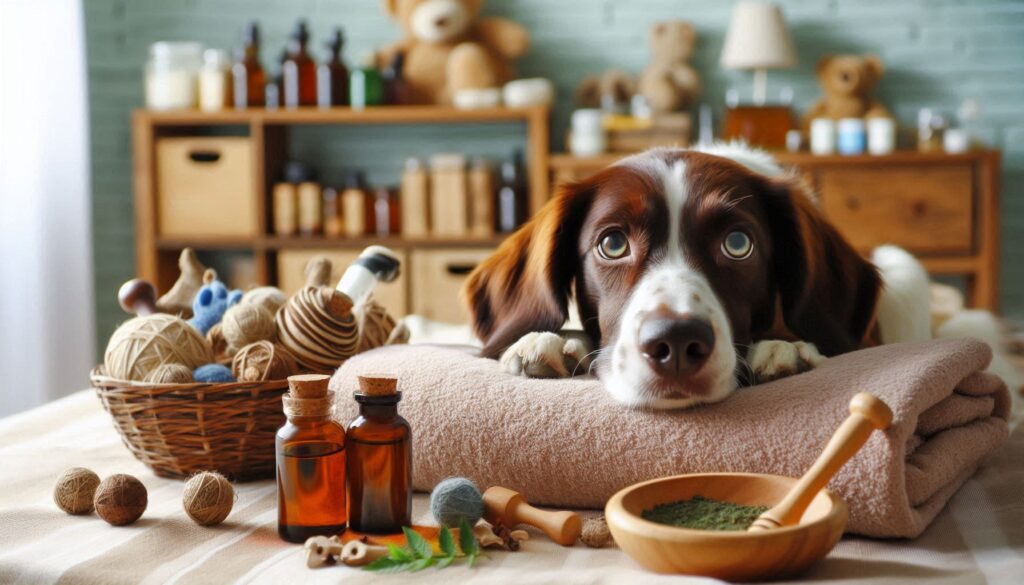Does your furry friend turn into a bundle of nerves when you reach for your car keys? Are thunderstorms a source of terror for your four-legged companion? If so, you’re not alone in the quest to find gentle, natural ways to ease your dog’s anxiety. In this comprehensive guide, we’ll explore a treasure trove of natural remedies that can help transform your anxious pup into a more relaxed and content canine companion.

Understanding the Roots of Canine Anxiety
Before we dive into solutions, it’s crucial to understand what might be causing your dog’s distress. Anxiety in dogs can stem from various sources:
- Separation anxiety when left alone
- Fear of loud noises (thunderstorms, fireworks)
- Changes in routine or environment
- Past traumas or lack of socialization
- Health issues or pain
Recognizing the signs of anxiety in your dog is the first step towards helping them. These may include excessive barking, destructive behavior, pacing, panting, or attempts to escape. If you notice these symptoms, it’s always a good idea to consult with your veterinarian to rule out any underlying health issues.
Nature’s Pharmacy: Herbal Remedies for Canine Calm
Mother Nature has provided us with a variety of herbs that can help soothe your dog’s frazzled nerves. Here are some of the most effective:
1. Chamomile: The Gentle Soother
Chamomile isn’t just for humans! This mild sedative can work wonders for dogs too. It’s particularly effective for dogs with nervous stomachs, as it can help calm both the mind and the digestive system.
How to use: Brew a weak chamomile tea and let it cool. You can add a small amount to your dog’s water bowl or food. For smaller dogs, use about 1/4 cup per 20 pounds of body weight. Always introduce new substances gradually and watch for any adverse reactions.
2. Valerian Root: Nature’s Tranquilizer
Valerian root has been used for centuries to promote relaxation in humans, and it can have similar effects on dogs. It works by increasing the amount of gamma aminobutyric acid (GABA) in the brain, which helps regulate nerve cells and calm anxiety.
How to use: Valerian root is available in capsule or liquid form. The recommended dosage is about 1/4 teaspoon of dried valerian root per pound of dog food. Start with a smaller amount and gradually increase as needed.
3. Lavender: The Aromatic Anxiety-Buster
The calming scent of lavender can work wonders for anxious dogs. Studies have shown that the aroma of lavender can help reduce anxiety in dogs during car rides and in shelters.
How to use: You can use lavender essential oil in a diffuser in your home, or apply a very diluted solution to your dog’s bedding. Never apply essential oils directly to your dog’s skin or allow them to ingest it.
4. Passionflower: The Relaxation Bloom
Passionflower has been shown to have anxiety-reducing effects similar to some prescription medications, but without the side effects. It can be particularly helpful for dogs that experience situational anxiety, such as during thunderstorms or fireworks.
How to use: Passionflower is available as a tincture or in capsule form. The general recommendation is 0.25 to 0.75 ml of tincture per 20 pounds of body weight, given two to three times daily.
Important Note: While these herbs are generally safe, always consult with your veterinarian before introducing any new supplements to your dog’s diet, especially if they are on any medications.
The Power of Touch: Massage and Acupressure
Sometimes, the most effective remedy is right at your fingertips. Massage and acupressure can be powerful tools for calming an anxious dog.
Canine Massage Techniques
Gentle massage can help relax your dog’s muscles and promote a sense of calm. Here’s a simple technique to try:
- Start by petting your dog all over to get them comfortable with your touch.
- Use gentle, circular motions with your fingertips, focusing on the neck, shoulders, and back.
- Pay attention to your dog’s reactions. If they seem to enjoy a particular spot, spend more time there.
- Keep the massage session short (5-10 minutes) to start, and gradually increase the duration as your dog becomes more comfortable.
Acupressure Points for Anxiety Relief
Acupressure is based on the same principles as acupuncture but uses finger pressure instead of needles. Here are two points that can help calm your dog:
- GV 20: Located at the highest point on the top of the head. Gently massage this point in a circular motion for 1-2 minutes.
- HT 7: Found on the inside of the front leg, just above the wrist. Apply gentle pressure for 30 seconds to 1 minute on each leg.
For more detailed guidance on canine acupressure, check out this informative article from The Whole Dog Journal.
The Calming Power of Exercise and Mental Stimulation
One of the most effective natural remedies for anxiety is good old-fashioned exercise. A tired dog is often a calm dog. Regular physical activity can help:
- Release pent-up energy
- Produce mood-boosting endorphins
- Provide mental stimulation
- Strengthen the bond between you and your dog
Aim for at least 30 minutes of exercise daily, tailored to your dog’s age, breed, and fitness level. This could include walks, runs, swimming, or games of fetch.
In addition to physical exercise, mental stimulation is crucial for keeping anxiety at bay. Puzzle toys, training sessions, and scent work can all help keep your dog’s mind engaged and reduce anxiety.
Creating a Calm Environment: The Importance of Safe Spaces
Dogs, like humans, benefit from having a safe, quiet space to retreat to when feeling overwhelmed. Create a “zen den” for your dog by:
- Choosing a quiet corner of your home
- Providing a comfortable bed or crate (if your dog is crate-trained)
- Adding some of your dog’s favorite toys
- Using a pheromone diffuser like Adaptil to promote calm
Encourage your dog to use this space by offering treats and praise when they go there voluntarily.
The Role of Nutrition in Canine Anxiety
What your dog eats can have a significant impact on their mental state. A balanced diet rich in omega-3 fatty acids, B-vitamins, and magnesium can help support your dog’s nervous system and potentially reduce anxiety.
Consider adding these anxiety-fighting foods to your dog’s diet (with your vet’s approval):
- Salmon or sardines (rich in omega-3s)
- Blueberries (high in antioxidants)
- Sweet potatoes (good source of B-vitamins)
- Spinach (rich in magnesium)
Some dog owners have reported success with CBD oil in managing their dog’s anxiety. While research is ongoing, anecdotal evidence suggests it may have calming effects. If you’re considering CBD for your dog, be sure to consult with your veterinarian first and choose a high-quality product specifically formulated for pets.
The Power of Routine and Predictability
Dogs thrive on routine. Establishing a consistent daily schedule can help reduce anxiety by making your dog’s world more predictable. Try to:
- Feed your dog at the same times each day
- Stick to a consistent exercise schedule
- Establish a bedtime routine
When it comes to separation anxiety specifically, practice short departures and gradually increase the time you’re away. This can help your dog build confidence and realize that when you leave, you always come back.
Clothing and Accessories for Anxiety Relief
Sometimes, a little extra “hug” can go a long way in calming an anxious dog. Consider these options:
- Thundershirts: These snug-fitting vests apply gentle, constant pressure to your dog’s torso, similar to swaddling an infant. Many dog owners swear by their effectiveness during thunderstorms or fireworks.
- Calming Caps: These fit over your dog’s eyes and reduce visual stimuli, which can be helpful in overstimulating environments.
- Anxiety Wraps: Similar to Thundershirts, these use acupressure and gentle compression to relieve stress.
Remember, while these products can be helpful, they should be used in conjunction with other anxiety-reducing strategies for the best results.
The Importance of Socialization and Training
Proper socialization and training can go a long way in preventing and managing anxiety in dogs. Expose your dog to a variety of people, animals, and environments from a young age (if possible) to help them build confidence.
Basic obedience training can also help anxious dogs by:
- Providing mental stimulation
- Strengthening the bond between you and your dog
- Giving your dog a sense of purpose and accomplishment
Consider enrolling in a positive reinforcement-based training class or working with a certified dog trainer who has experience with anxiety issues.
When to Seek Professional Help
While natural remedies can be very effective, there are times when professional help is necessary. If your dog’s anxiety is severe or not improving with home remedies, it’s important to consult with a veterinarian or a certified animal behaviorist.
They may recommend a combination of behavior modification techniques and, in some cases, medication. Remember, seeking help is a sign of being a responsible and caring pet owner.
The Human Touch: Your Role in Your Dog’s Anxiety Management
As a dog owner, you play a crucial role in managing your pet’s anxiety. Your own emotions and behavior can significantly impact your dog’s state of mind. Here are some tips:
- Stay calm: Dogs are sensitive to our emotions. If you remain calm during anxiety-inducing situations, it can help your dog feel more secure.
- Be patient: Overcoming anxiety takes time. Celebrate small victories and don’t get discouraged if progress seems slow.
- Provide consistent love and support: Your dog looks to you for security. Regular positive interactions and affection can boost your dog’s confidence.
- Educate yourself: The more you understand about canine anxiety, the better equipped you’ll be to help your dog. Consider reading books on dog behavior or attending workshops on canine body language.
Real-Life Success Stories
To provide some inspiration and proof that natural remedies can work, here are a few success stories from dog owners who have successfully managed their pets’ anxiety:
“My rescue dog, Max, used to tremble uncontrollably during thunderstorms. We started using a combination of lavender essential oil in a diffuser and a Thundershirt, and the difference is night and day. He still doesn’t love storms, but he can now relax and even sleep through them.” – Sarah L., Boston, MA
“Separation anxiety was a huge issue for our Labrador, Luna. We worked with a behaviorist who recommended a combination of desensitization training and valerian root supplements. It took time, but Luna can now comfortably stay home alone for a few hours without any signs of distress.” – Michael T., San Diego, CA
For more success stories and to connect with other dog owners dealing with anxiety, check out the r/reactivedogs community on Reddit. It’s a supportive space where pet owners share experiences and advice.
Conclusion: A Holistic Approach to Canine Calm
Managing dog anxiety is not a one-size-fits-all process. What works for one dog may not work for another, and often a combination of approaches is most effective. The key is to be patient, observant, and willing to try different strategies.
Remember, natural remedies can be powerful tools in your anxiety-fighting toolkit, but they should be used as part of a comprehensive approach that includes proper nutrition, exercise, training, and lots of love and understanding.
By taking a holistic approach to your dog’s anxiety, you’re not just treating symptoms – you’re enhancing their overall quality of life. With time, patience, and the right combination of natural remedies, you can help your anxious dog become a more relaxed, confident, and happy companion.
Frequently Asked Questions
1. Can I use essential oils to calm my dog?
While some essential oils can have calming effects on dogs, it’s crucial to use them with caution. Never apply essential oils directly to your dog’s skin or allow them to ingest them. Diffusing lavender oil in small amounts can be safe and effective, but always introduce new scents gradually and watch for any adverse reactions. Some essential oils, like tea tree oil, can be toxic to dogs, so always consult with your veterinarian before using any aromatherapy products around your pet.
2. How long does it typically take to see results from natural anxiety remedies?
The timeline for seeing results can vary greatly depending on the individual dog and the specific remedy being used. Some dogs may show improvement within a few days, while others might take weeks or even months to show significant changes. Consistency is key – stick with a remedy for at least 2-4 weeks before deciding whether it’s effective. Remember, managing anxiety is often an ongoing process rather than a quick fix.
3. Are there any breeds that are more prone to anxiety?
While any dog can experience anxiety, some breeds seem to be more predisposed to it. Breeds that are known for being highly sensitive or energetic, such as Border Collies, German Shepherds, and Bichon Frises, may be more prone to anxiety. However, it’s important to remember that individual personality and experiences play a significant role in a dog’s likelihood of developing anxiety, regardless of breed.
4. Can changes in diet really impact my dog’s anxiety levels?
Yes, diet can have a significant impact on your dog’s mental state. A balanced diet that includes nutrients known to support brain health and reduce anxiety, such as omega-3 fatty acids, B-vitamins, and magnesium, can potentially help manage anxiety symptoms. Some dogs may also have food sensitivities that contribute to anxiety-like behaviors. If you suspect this might be the case, consider working with your vet to try an elimination diet to identify any problem foods.
5. Is it possible for a dog to completely overcome anxiety, or is it a lifelong condition?
While some dogs may always have a tendency towards anxious behavior, many can show significant improvement with proper management and treatment. In some cases, especially if the anxiety is related to a specific event or lack of socialization, dogs can overcome their anxiety entirely. However, for many dogs, managing anxiety is an ongoing process. The good news is that with consistent effort and the right strategies, most anxious dogs can become much more relaxed and confident, greatly improving their quality of life.


